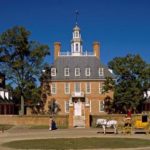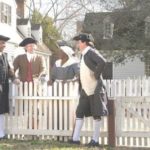“George Washington”
Photos/Colonial Williamsburg Foundation
By Victor Block
As the pounding of the sheriff’s wooden staff calls the court to order, James Hubbard prepares to defend his client. He is an orphan’s guardian who stands accused of squandering his charge’s estate.
Centering his neat wig and smoothing the frilly lace sleeves of his shirt, the attorney bows to the bench and begins to plead his case.
This scene is repeated today in the same place where it occurred during the 1770s. That is when James Hubbard lived and practiced law in Williamsburg, at a time that the town served as the capital of the Virginia colony. The actor-impersonator who depicts this historical figure bases his interpretation upon facts that historians have been able to document. For example, he describes having returned to London to study law, and rather sheepishly admits that his wife occasionally agitates him.
For those who love living history, James Hubbard plays but a small part in a fascinating tableau that makes Colonial Williamsburg a perfect place to relive pages from the past. Reenactments, tours led by factually based characters and many other interpretive programs combine to involve visitors in the interest, information and fun.
The meticulously restored 17th– to 19th-century historic area provides the Colonial and Revolutionary War-era setting in which chapters from our nation’s early years are dramatically revived. For nearly a century, from 1699 to 1780, Williamsburg served as the capital of the Virginia Colony, a vast enclave which stretched west to the Mississippi River and north to the Great Lakes.
In its early heyday, the town of about 2,000 residents was the cultural, social and political center of the Colonial world. Before Thomas Jefferson relocated the Virginia capital to Richmond in 1781, he and other patriots, including George Washington and Patrick Henry, frequented its shops, taverns and other establishments. After the Revolution, Williamsburg’s importance, and fortunes, declined.
That continued until 1926, when John D. Rockefeller Jr. launched a major effort to restore the setting to its former splendor. The surviving 88 Colonial structures were renovated to their 18th-century appearance, and those that no longer stood were reconstructed on their original sites, based upon research and as much documentation as could be found.
Today, more than 500 history-touched buildings – imposing public structures and modest houses, bustling taverns and shops where merchants ply their trade – line tree-shaded streets that echo the clip-clop of horse-drawn carriages. Gardens and “dependencies,” including free standing kitchens, smoke houses and privies, add to the atmosphere and authenticity.
Along with this historically accurate scene, it’s primarily people who bring historic Williamsburg to life. Character interpreters dressed in Colonial-style clothing, many depicting real-life former residents of the town, converse with visitors in period grammar as they go about their daily tasks.
Part of the fun is trying to convince the actors to drop the persona of the person they represent, which invariably fails. I attempted that while dining in Chowning’s Tavern, a reconstructed 18th-century alehouse. My good-natured effort to have Edmund Pendleton, who was a delegate to the First Continental Congress and a leader in Virginia’s move to independence, reveal his true self was unsuccessful.
Fortunately, that was not completely true when I handed my waitress a credit card to charge the meal and she asked, “What’s this? We usually are paid in gold.” Not wishing to part with my single gold filling, I was relieved when she agreed to take “whatever this is to see if my master will accept it.”
Chefs in several kitchens demonstrate the use of “receipts” (recipes) from 18th-century cookbooks to prepare authentic dishes on a hearth. Presentations of dance, singing and other activities recall aspects of the lives of the half of Colonial Williamsburg’s population who were black.
Costumed artisans use 18th-century tools to fashion items similar to those made by their Colonial predecessors. The bookbinder carefully hand-stitches cover boards for a new volume. A shoemaker fashions men’s boots “with good thread well twisted.”
Among other historic tradespeople are basket weavers, a cabinet maker and milliner. The results of their efforts are sold in stores along Duke of Gloucester Street.
Leaving no stone unturned, figuratively as well as literally, archaeologists and historians transform research and construction projects into learning experiences for the public.
For example, the courthouse where trials take place has been reconstructed as closely as possible to its original design, based upon clues to its former appearance found in early documents. Costumed carpenters used tools and techniques of Colonial times to restore the building, as visitors looked on.
As a result, James Hubbard and other figures from the past depict life as it once was in surroundings that would be familiar to the people whom they represent. One benefit of such attention to detail is an all-encompassing trip back through time for today’s visitors.
They may enjoy a theatrical comedy and a traveling magic show reminiscent of entertainment in the 18th century. Among choices for shoppers are inkwells, silver coffee pots and other souvenirs and gifts hand-fashioned by craftsmen in ways of old. Those interested in legalities may observe Colonial justice in action, and perhaps even play a role in the court proceedings. It’s all part of the immersion in the past available at Colonial Williamsburg.
For more information, call 844-574-2733 or log onto colonialwilliamsburg.com.














